Visited Scion at Fieldays 2023 and want to know more?
Forestry at the heart of transitioning Aotearoa to a low-carbon, circular bioeconomy
This years’ Fieldays continued with the low-carbon future theme and explored how the transition to a circular bioeconomy is a focus for the Forestry industry. The event provided the opportunity to launch Scion’s new booklet, A New Zealand Guide to Growing Alternative Exotic Forest Species, with the message that there is more to forestry than pine. Co-created with industry and with research input from Scion, the booklet provides small landowners and key players with information about the different exotic commercial species available.
The Forestry Hub introduced several forums this year where Scion’s General Manager Forests to Timber Products, Henri Bailleres discussed whether all trees are created equal, and Portfolio Leader Distributed and Circular Manufacturing, Marc Gaugler presented the concept of Distributed manufacturing – bringing the factory to the forest.
Our stand at Fieldays within the Forestry Hub showcased some of these innovations and initiatives. Expand the links below to learn more and access direct contact details.
Distributed manufacturing
Mini factories that use residues from production forests, or horticultural, crop and natural fibres to create new wood products, biochemicals and biomaterials.
Further reading
For more information contact
Precision forestry - making every tree count
Making every tree count requires a paradigm shift towards precision. The forestry industry will need to continue the transition from highly manual systems and processes to digitisation, automation, mechanisation and the ability to draw insights from big data. Increasingly, foresters will be able to remotely and precisely apply management decisions to individual trees.
Advances in remote sensing technologies, unmanned aerial vehicles (UAVs) and computing power are helping make precision forestry happen. Scion uses UAVs to collect LiDAR data, multi-spectral imagery and hi-definition video. The pathways and systems that we are developing for data processing will translate data into information forest managers can use to manage commercial forest estates remotely.
There are significant opportunities for industry partners to work with Scion in identifying, testing, and evaluating these technologies.
As one example, Scion has been working with Hawke’s Bay forestry company Pan Pac Forest Products to develop and test a range of precision forestry technologies to make informed decisions on pruning individual trees and planning where to plant.
Further reading
For more information contact
The richness of soil
Forest soils are among the most complex ecosystems on earth – and soils under radiata pine forests in New Zealand are no exception.
If you visited our stand at Fieldays, you may have spoken to one of our people about the richness of the soil under radiata pine and the microbiome that exists around the root of a tree.
Microorganisms have a huge impact on how trees can access water and nutrients and they play a role in how carbon is stored. Understanding the tree microbiome can help us understand how pine trees cope with climate change.

Scion’s Puruki Experimental Forest in the Central North Island is one of the most productive radiata pine plantations in New Zealand. Why? Its soil is rich in nutrients.
Pine growth rates at Puruki are nearly double what is being achieved at New Zealand’s largest planted forest, Kaingaroa Forest, where radiata pine makes up 95 per cent of the forest’s 205,000 hectares.
Essentially the soils are the same but with Puruki having a greater nutrient capital. If fertiliser was applied to the forest to improve growth rather than to address a deficit, the potential exists to increase pine growth rates in Kaingaroa.
Further reading
- Back to our roots: Visiting the original home of Pinus radiata
- Forest soils to the rescue
- Forest microbiomes: Small actors play a big part
- Timberlands’ big, hairy, audacious goal
- Puruki Experimental Forest
For more information contact
Carbon solutions for your farm
Planting trees in non-forested landscapes increases the carbon stock in that landscape. Trees absorb CO2 from the air as they grow and use the carbon to form wood, foliage and roots. The rate at which CO2 is absorbed from the atmosphere depends on the growth rate of the trees and it varies with temperature, rainfall and soil nutrients. This in turn varies with species: radiata pine, coast redwood and eucalypts generally grow faster than native species, storing more carbon in a shorter time.
Scion scientists have computer-modelled different species planting as an alternative to radiata pine forests.
At Fieldays, a graphic compared the predicted rates of carbon sequestered per ha per year of radiata pine, redwood, Douglas-fir, Eucalyptus fastigata, and Cupressus lusitanica over an 80-year timescale.
Computer modelling studies by Scion have shown that, in general, productivity and carbon storage potential are greater in the North Island, but highly productive sites can be found in the South Island.
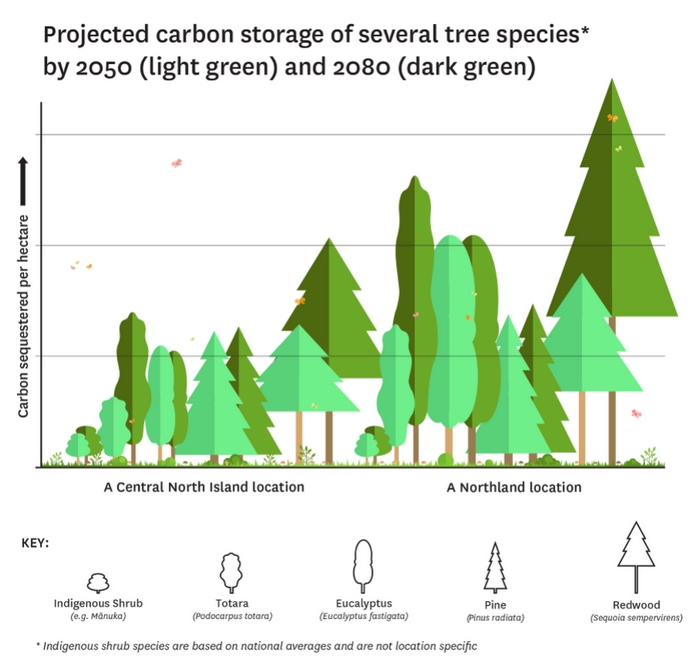
Further reading
- Planted forests and carbon infosheet
- New approach to predict growth of forestry tree species
- Redwood could help NZ reach 2050 net-zero emissions target
For more information contact
Advanced tissue culture
Exotic and indigenous tree species need to be produced at scale and deployed into our forests as fast as possible if New Zealand is to meet its zero carbon commitments by 2050. This means ensuring a high rate of germination success is critical.
Scion is using advanced tissue culture techniques to help multiply the best trees by the tens of thousands and to shorten the interval to get a new radiata pine genotype into commercial production from 20 years to about nine years.

Using next-generation technology including machine learning tools for germination success prediction, Scion is transforming the way somatic embryos are matured, selected, and germinated.
An algorithm quantifies the morphological (shape) characteristics of embryos and uses these measurements to predict germination success. This effectively measures significantly more morphological features than can be detected by the human eye resulting in a high degree of germination success.
This pivotal work represents an industry transformation and will ensure we can get more elite trees into nurseries and out into the forest to meet market demand.
Further reading
For more information contact
Precision DNA Selection
Planting the right tree in the right place for the right purpose starts with knowing your tree. While one pine seedling may look identical to its neighbour, subtle differences in their genetic makeup may have big implications in the future. One tree may be better able to handle drought stress or insect attack, while another may have the wood density and stiffness that our building industry demands.
The SNP panel, as shown at Fieldays, was developed by the Radiata Pine Breeding Company and Scion. It contains a wealth of DNA knowledge – it can tell us the pedigree of the tree and which variations of genes are associated with traits of importance to foresters. This can help us create more resilient and profitable future forests.

Further reading
For more information contact
Māori partnerships
At Scion, we work with whānau, hapū, and iwi – including kaitiaki of the whenua and Māori forestry and farming expertise - to find solutions that will benefit the forests of tomorrow.
This includes methods to reduce the carbon impact from farming, new ways of viewing and valuing the ngahere (forest), preserving fresh water, and growing and using taonga species such as tōtara for future generations.
Our solutions draw on both Te Ao Māori – the Māori worldview – and Scion’s science and technological knowledge.

At our Fieldays stand, you might have seen or talked to a member from Te Rata Whakamaru – the ‘Myrtle Rust Jobs for Resistance’ programme, a partnership with Rotoiti 15 Trust, the Department of Conservation and Scion. This programme is unique and aimed at providing opportunities for upskilling and developing knowledge of myrtle rust, working within the forest and plant laboratory environments. “The goal is to provide jobs and build capability within the Bay of Plenty to protect the ngahere against myrtle rust.”
The signing of a collaboration agreement between Scion and the Māori Carbon Collective in November 2021 is another example of working together to achieve a joint objective. The agreement means Māori landowners will have new opportunities to engage with scientists to create intergenerational pathways for whenua and whānau.
Scion is trialling the planting of a mix of radiata pine and native trees on whenua for carbon farming, where eventually the native species will take over to become fully native again.
A kaupapa introduced in early 2022 aims to develop a transition strategy to shift from exotic pine to an indigenous forest system through rangahau and research, wānanga, and indigenous forestry trial sites. Led by Ngāti Hine Forestry Trust and supported by Scion, the project is significant because it not only considers kaupapa Māori approach, but it is also unique to Ngāti Hine Mātauranga through rangahau philosophy that incorporates Te tū o Ngāti Hine, kaitiakitanga, mahi tahi and He Whenua Hua, He Tangata Ora.

Further reading
- Science recruits target myrtle rust species
- New science recruits put myrtle rust in the spotlight
- Collaboration agreement with Māori Carbon Collective
- Partnering with Māori
- Māori partnerships
For more information contact
Te Whare Nui o Tuteata in Rotorua
Scion’s new three-storey building, Te Whare Nui o Tuteata, is a carbon-neutral build thanks to its ability to store the equivalent of 454 tonnes of carbon dioxide in its wood. That is comparable to taking 200 cars off the road each year.
Te Whare Nui o Tuteata is the biggest three-story timber diagrid structure anywhere in the world.
A 3D-printed scale model of Te Whare Nui o Tuteata in Rotorua was on display at Fieldays. It shows the intricate diagrid structure that makes up this impressive building.

The diagonal grid pattern of the building allows plenty of light to pour in and is extremely strong. It will rock but not break in an earthquake.
The V-shaped diagrid displayed at Fieldays demonstrated the strength of the diagrid components. This diagrid was tested at Scion, with the apex portion subjected to 45 tonnes of downward pressure and then pulled upward by a 31.5-tonne force.
The building showcases what is possible to do with sustainably sourced wood from New Zealand's forests. Approximately 550m3 of timber was used in the building. Our forests can grow that amount of wood every 35 minutes.
Our scientists are finding new ways to grow resilient forests from indigenous and exotic species. Meanwhile, Scion technology is creating timber products never dreamt of before.
Further reading
- Building Te Whare Nui o Tuteata
- RNZ article and interview with Doug Gaunt and Andrea Stocchero
- Prime Minister Jacinda Ardern opens Scion's new front door - Te Whare Nui o Tuteata
For more information contact
These shoes were tanned with pine bark
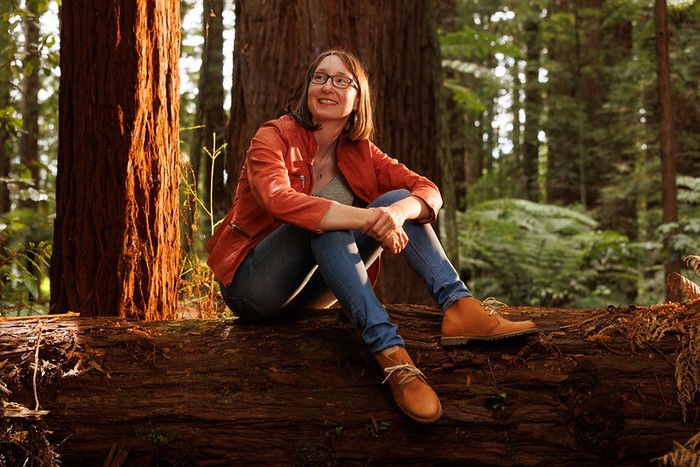
The New Zealand forestry estate produces two million tonnes of pine bark a year, most of which goes to waste. When pine trees are felled for export, the bark must be removed for biosecurity reasons. The bark is discarded, with just a fraction used for low-value applications such as garden mulch.
Now, thanks to some clever chemistry, we have extracted tannins from pine bark to tan and create a beautiful pair of boots. Not only this, but in the future, bark biorefineries may create a range of high-value chemicals and materials such as cosmetics and nutraceuticals.
At Fieldays, the world’s only pair of leather shoes tanned using radiata pine bark tannins were on display.

These have been in the making for two years. Using Scion’s pine bark tannin, Dunedin domestic shoe manufacturer, McKinlays Footwear, created this first proof of concept in late 2021 and noted that the bark-tanned leather cut and handled in the factory as well as any chrome tannage.
There is still a way to go, but locally grown tannins could one day compete with other tannin sources, reducing our dependence on imports and providing exciting new opportunities.
Furthermore, the fact that the tannins are produced locally and build towards a sustainable circular bioeconomy, adds value.
Further reading
For more information contact
Vine clips
Every year the New Zealand wine industry uses up to 30 million vine clips to hold protective nets over ripening grapes, keeping birds and other pests away. After six to eight weeks the nets are removed, and the clips fall to litter the ground and contribute to microplastic pollution.
A collaborative partnership between science, industry and end users has resulted in the biodegradable PolyNatural® Terrain vine clip.
At our Fieldays stand, you would have been able to touch and feel our winning vine clips made from waste created from processing wood and also from grapes, which was part of a collaborative effort between Scion and EPL.

Scion biomaterial experts saw an opportunity to combat the environmental issue of vine clips falling off the vines and contributing to microplastic pollution or extra labour to collect and dispose of them.
They designed a clip made from biodegradable thermoplastic. Once the clips fall on the ground, they naturally break down before a new wine-producing season comes around.
Further reading
- Biodegradable vine clips win Outstanding Collaboration Award
- PolyNatural® Terrain vine clips
- PolyNatural® - video
For more information contact

Table from a log
Bringing to life precision forestry, we have the potential to better match trees to their ultimate purpose.
Made by No Boundaries Furniture, a table made from a log was on display. The contents of this simple macrocarpa log demonstrate the application of selection, design, and form to create a much larger piece of furniture. The log is the home of the nested table components. There is a contrast between the compact table components within the log and the table which envelops a much greater space.

Further reading
Trubridge cascade light
Showcasing New Zealand design, the cascade pendant light system, on display at Fieldays, is made from a composite of sustainable bio-based plastics and harakeke (flax) developed by Scion scientists.

The lamps were designed by David Trubridge who is a recognised leader in sustainable design for his high-end lighting that is produced with minimal environmental impact.
These lamps show what’s possible. As we bring our innovative biomaterials to life, we find more uses for natural materials growing in our forests and elsewhere.
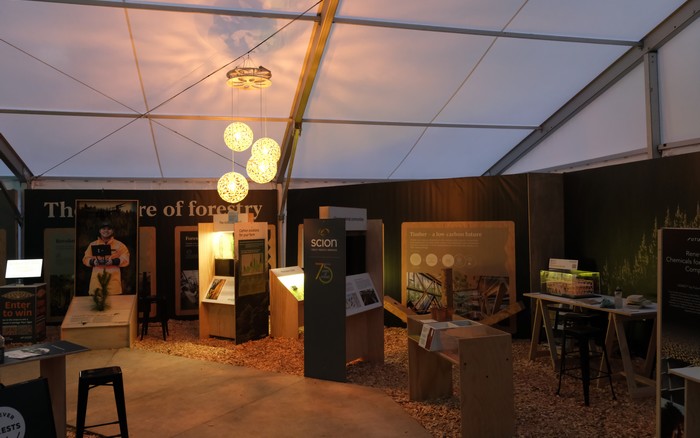
Further reading
For more information contact
Thermoformer trays
Growing global demand and requirements for recyclable, reusable and compostable packaging is significant for New Zealand as an export nation. Scion’s recent investment in a Kiefel moulded fibre thermoformer has enabled research into new bio resources for packaging and waste.
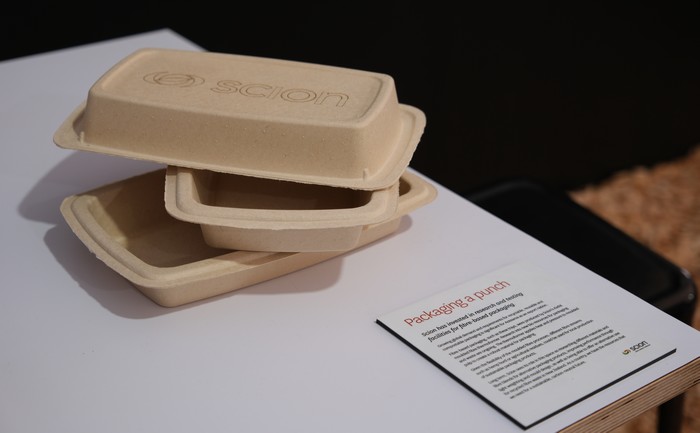
On display at fieldays were trays manufactured by the Thermoformer – they are moulded from pulp where heat and pressure are applied to create a robust material for packaging. Different material and fibre blends are part of ongoing testing for alternative packaging product solutions.
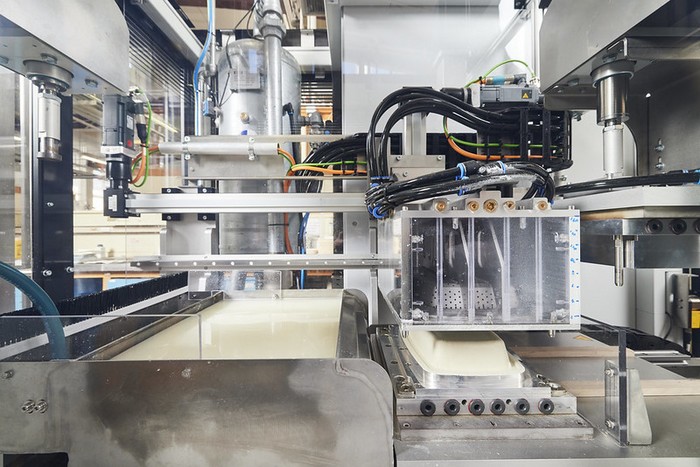
Further reading
For more information contact
Biodegradable nursery pots
Innovative biodegradable nursery pots made from sugarcane, cassava or corn biopolymers and a bio-filler have been developed after four years of research as part of Scion’s commitment to helping New Zealand transition to a circular bioeconomy.
Conducted for client Wilson and Ross, the successful prototype, PolBionix, provides an eco-friendly alternative to the 350 million plastic containers used annually in New Zealand nurseries. The product meets nursery requirements, lasts for at least 12 months above ground, and biodegrades after planting providing fertiliser for plant growth.
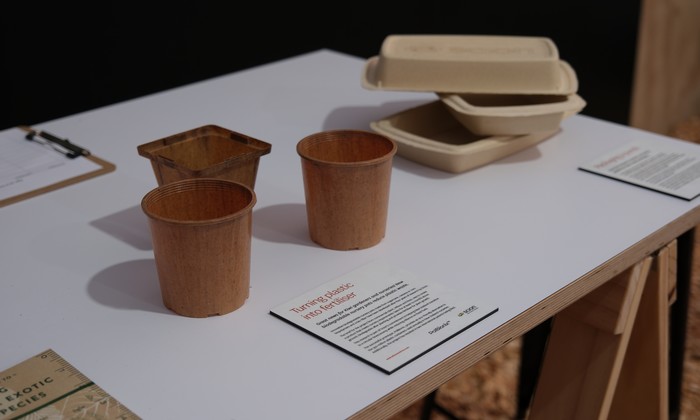
Further reading
For more information contact
Indigenous and introduced bugs
Biodiversity and biosecurity were highlighted at the Forest Owners Association (FOA) Fieldays stand, which featured an intricate and beautiful display of New Zealand bugs.
Split into categories ‘indigenous’ and ‘introduced’ the artwork celebrated the biodiversity that exists in New Zealand’s forests as well as the exotic things we are trying to keep out.

The artwork featured almost 250 different species, all of which were taken from the National Forestry Insect Collection.
Curated and housed by Scion, it is an internationally registered collection of forest insects from New Zealand and overseas containing nearly 150,000 specimens dating back to 1948.
The collection is an essential research, diagnostic and archival resource for forest health work both in New Zealand and overseas. It is used routinely to provide identification and diagnostic services for two major pest detection surveillance programmes: the Ministry for Primary Industry’s High Risk Site Surveillance programme and the New Zealand Forest Owners Association’s Forest Surveillance Programme.
The purpose of these programmes is early identification of new-to-New Zealand insects or pathogens, or disease behaviours that could have significant biosecurity implications for New Zealand’s trees and forests.
